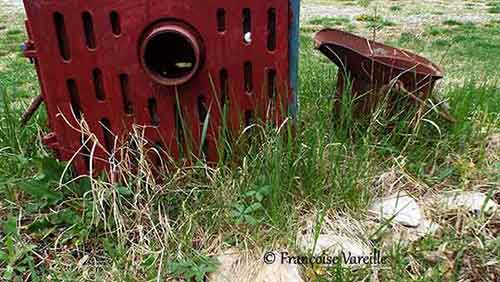
Many thanks to Françoise Vareille for this wonderful observation.
The text was written by Nicole Bouglouan, according to the notes and information provided by Françoise Vareille.
All pictures on this page are owned by Françoise Vareille.
These images and the text are subject to copyright and cannot be used without express authorization from the owners. Legal issues
Reproduction of the Great Tit in the garden
(Parus major)
March - April - May - June - July 2019
Some gardens are true paradises for birds. Françoise's garden is a fantastic place where a lot of things are happening ...
Since several years, the Hoopoes are nesting in an old cask located in the field behind the house.
See the reports:
Reproduction of the Eurasian Hoopoe 2016
And also:
Reproduction of the Eurasian Hoopoe 2017
Another smaller cask is not far from the first. But an old stove and an old rusty watering can also represent interesting places to build a nest.
This year, in addition to hoopoes that have returned once again in their cask, Great Tits have been very attracted by these strange but very practical objects to raise their young.

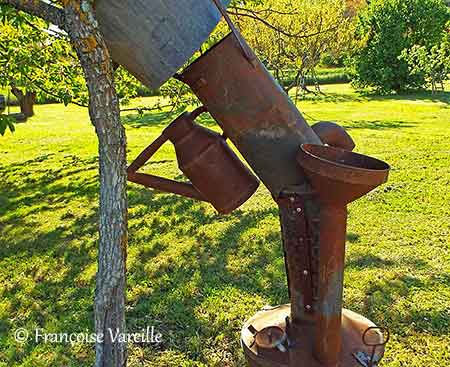
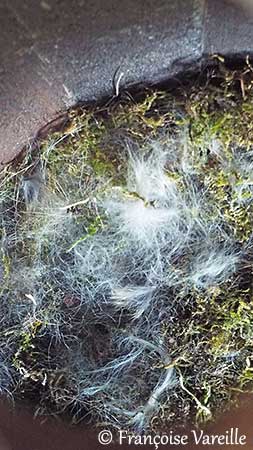
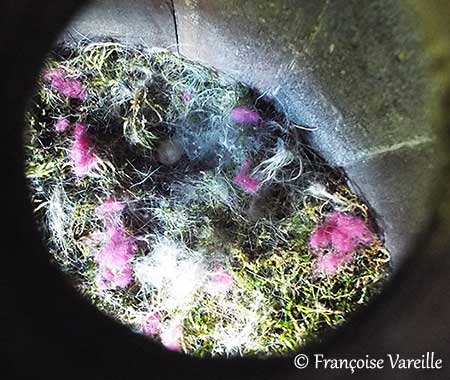
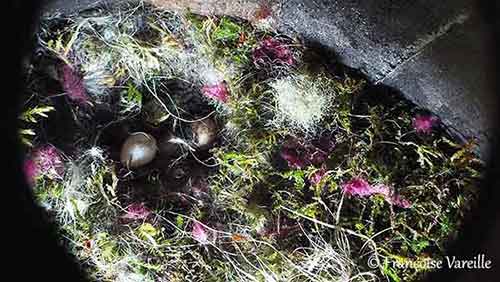
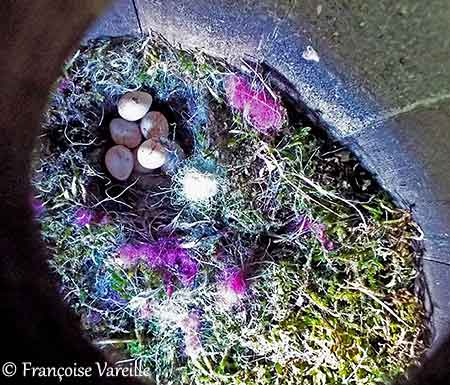
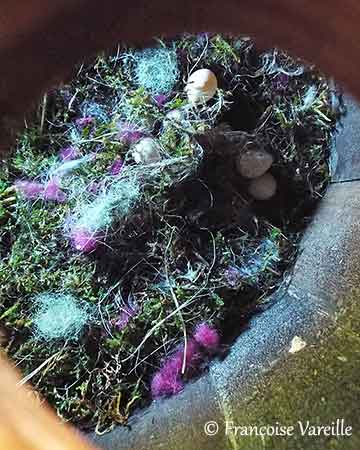
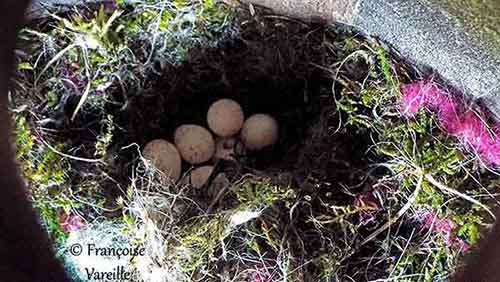
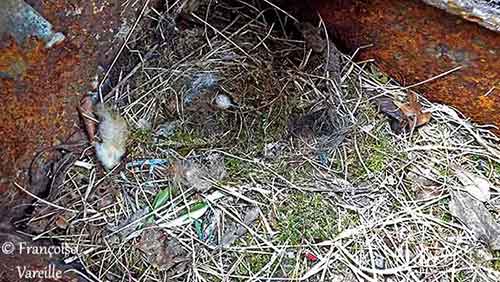
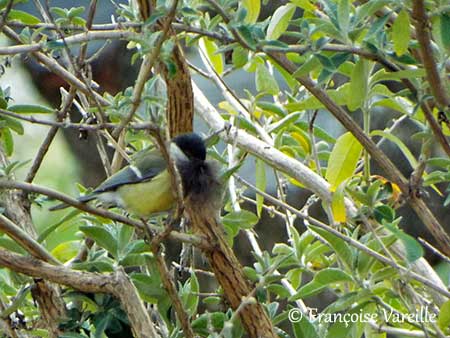
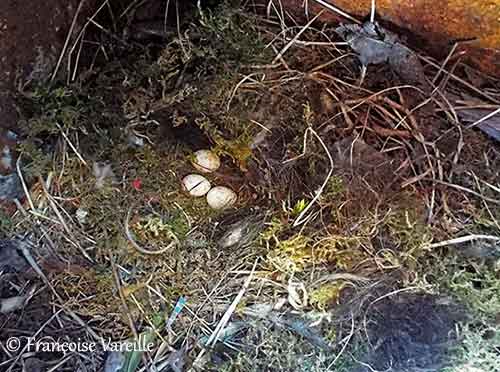
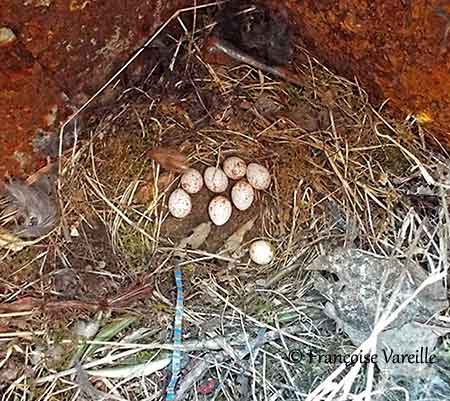
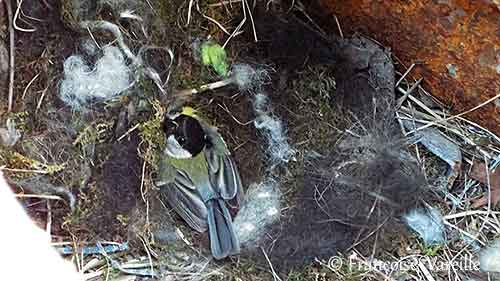
BUT ... a few movements around the beautiful rusty watering can alerted Francoise. And on May 4, a surprise awaited her: a pretty nest was at the bottom! A second pair of Great Tits had taken up residence here.
The nest was very similar to the first, the "pink nest" which was in the small cask. It was very pretty and clean, with white hairs and the famous pink wool. Probably the occupants of the destroyed nest!
We know that many species produce one or more replacement broods when one of them is lost for any reason. This is a wonderful illustration of this behaviour.
The female was incubating on May 4, about 18 days after the first nest was destroyed.
Now, it only remains to wait!
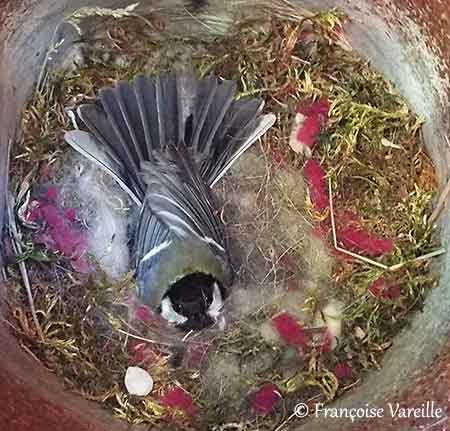
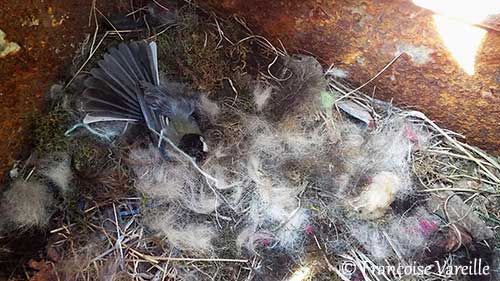
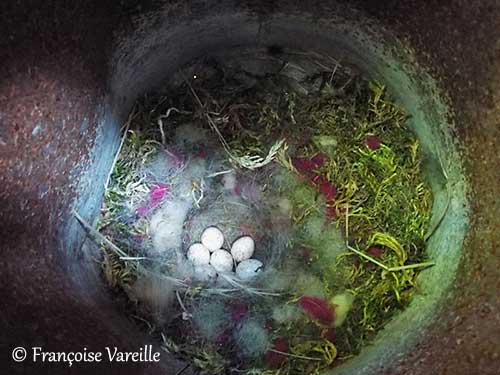
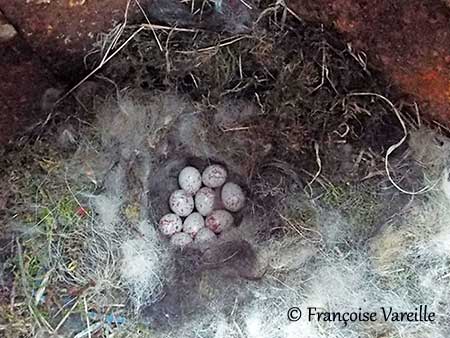
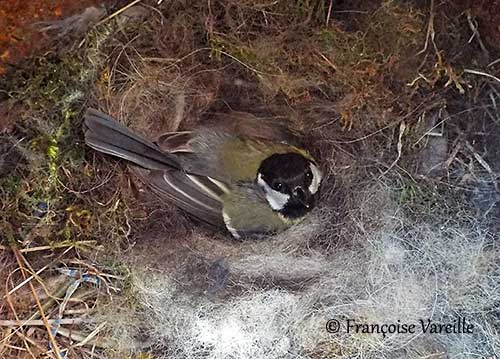
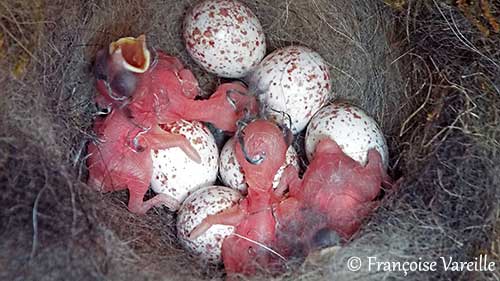
May 10
Old stove
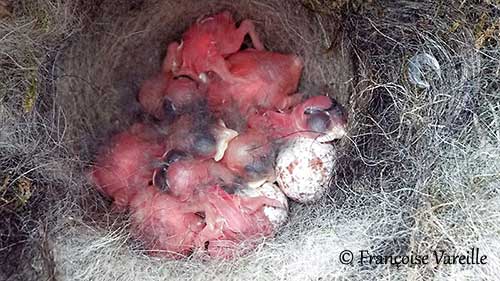
May 11
Old stove
But in the watering can, the births also begin on May 10. There are now four pink little things fluttering in the nest.
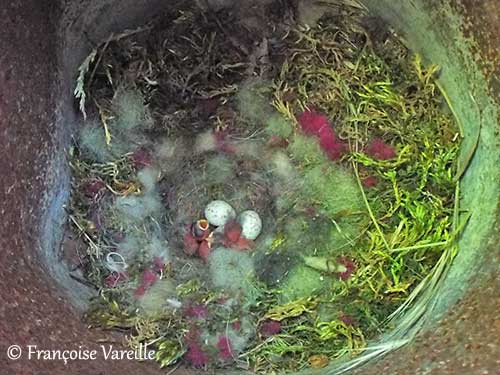
May 10
Watering can
It is interesting to mention that the births occurred at almost the same time in both nests, indicating that the pair that was nesting in the cask and was disturbed at the beginning of the season produced a replacement brood in the watering can very quickly after the first nest failure.
On May 12, we can see nine chicks on the eleven eggs laid in the old stove and counted on April 27.
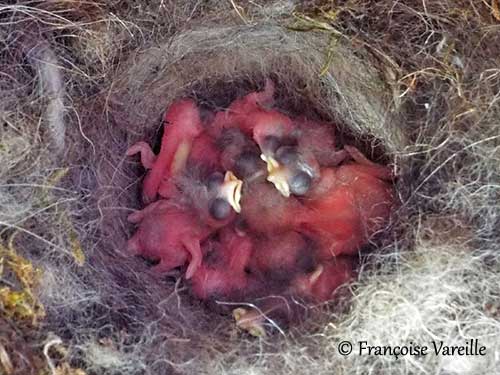
May 12
Old stove
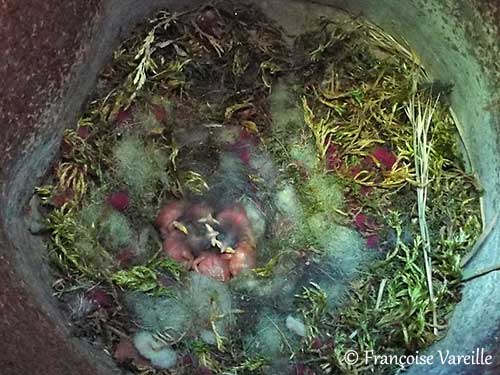
May 12
Watering can
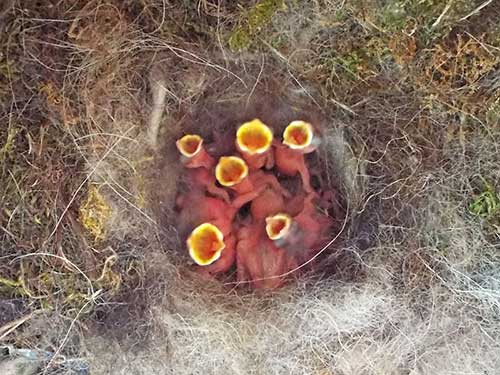
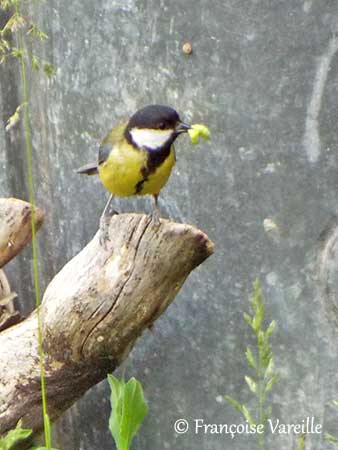
May 13
Old stove
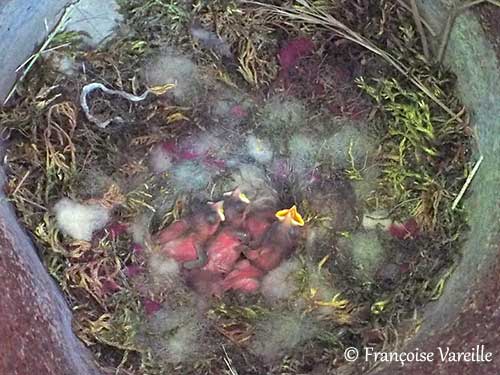
May 14
Watering can
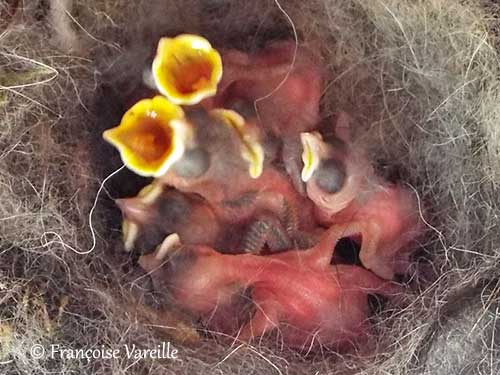
May 14
Old stove
In the picture below, we notice that the feather rachis are already visible on the wings. They grow up very well!
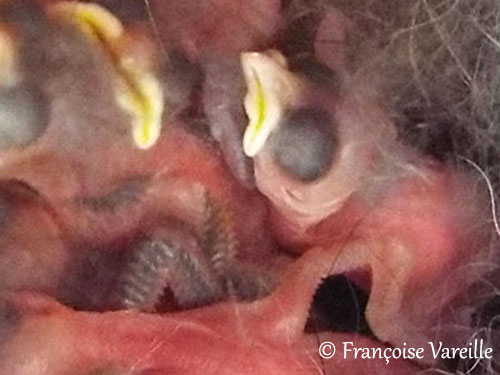
May 14
Old stove (detail)
On May 15, things are going smoothly in the old stove. The feathers grow fast and the chicks are doing well, proof that food abounds in the surroundings.
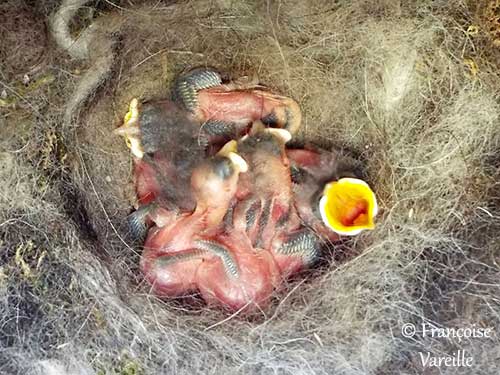
May 15
Old stove
On May 16th, the chicks of the watering also show their growing feathers. The hungry little one opens widely his bright yellow bill to direct the adult if necessary.
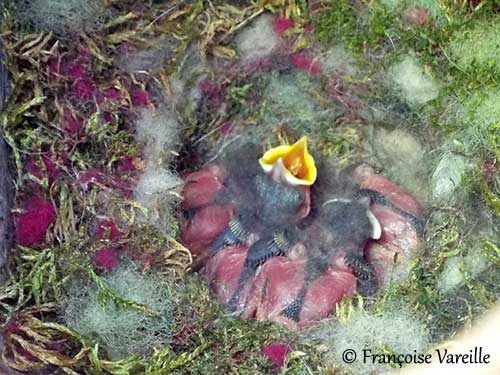
May 16
Watering can
On the two pictures above, it is interesting to note the bright colour of the open bill, ready to receive the food! This bright colour is intended to help the adult to gain time while searching for the bill to feed.
If these two nests are sufficiently enlightened, many others are often in the dark, hence the interest of these colours clearly visible.
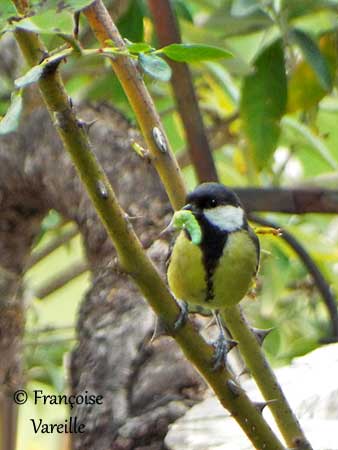
Tirelessly, adults come and go, wearing these famous green caterpillars so much appreciated by the chicks. Here the female is still working, but the male is certainly not far away.
Finally, at the end of the day, a little rest is welcome!!! The adult spends the night with the chicks to protect and guard them.
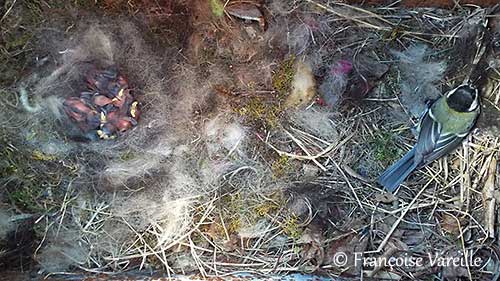
May 16
Old stove
It is the same in the watering can, but there, the adult still broods the chicks. It is true that they are less numerous than in the stove!
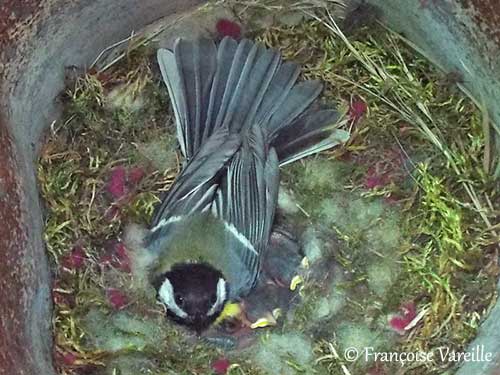
May 16
Watering can
We notice that the feathers grow really fast. It’s fantastic!
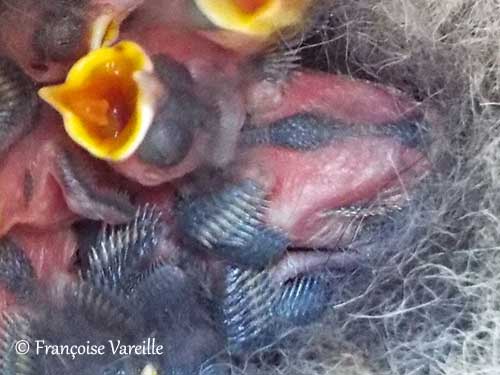
May 16
Old stove
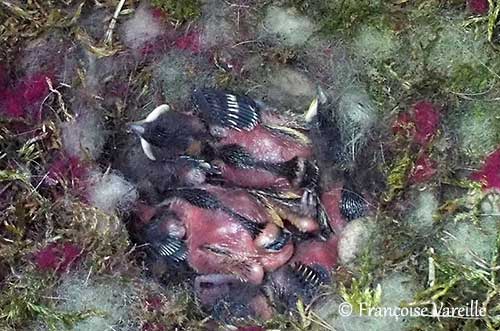
EGG
May 18
Watering can
In the old stove, the adult broods the little ones. Their reflexes work well because they open the beak even when the photographer comes to see them!
What is certain is that the parents take care of them very well and the food abounds in this garden. Both nests are progressing well and favorably.
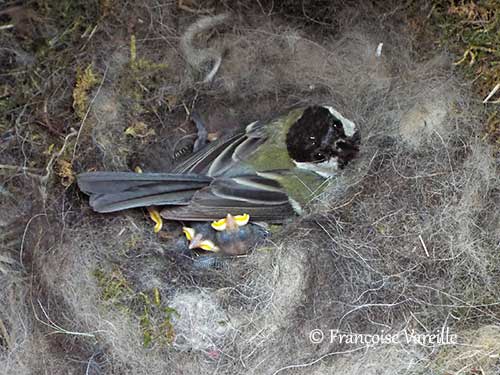
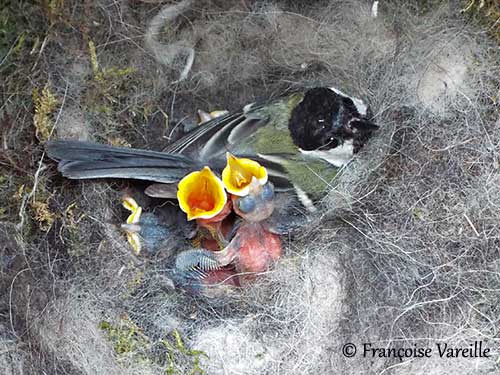
May 18
Old stove
May 18
Old stove
It is also interesting to note certain uniformity in each nest, especially in terms of colour.
If the nest of the stove is rather sober, with a lot of white hairs and little colored wool, that of the watering can on the other hand is a work of art! The pink wool balls rub shoulders with small packets of white wool to form a real impressionist painting by juxtaposing touches of colour on the green background made by the moss. On May 17th, a thin pink string came to complete the ensemble.
Each nest is regularly cleaned and arranged, and the whole remains beautiful to see despite the comings and goings of adults and the activity that has reigned in recent days.
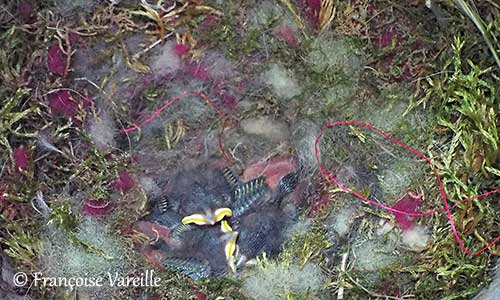
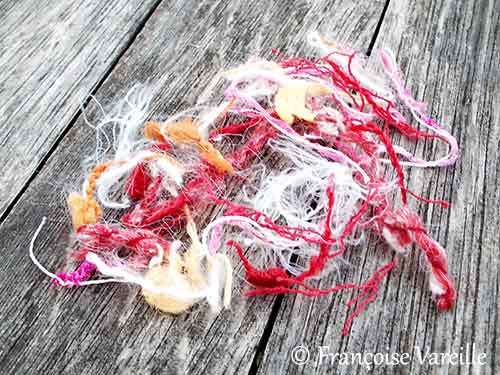
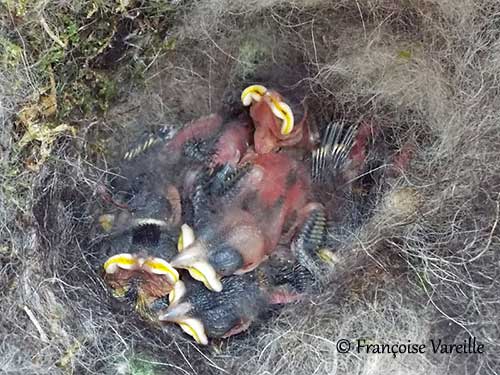
May 19
Old stove
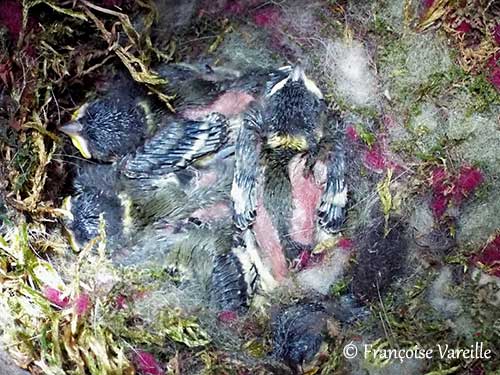
May 21
Watering can
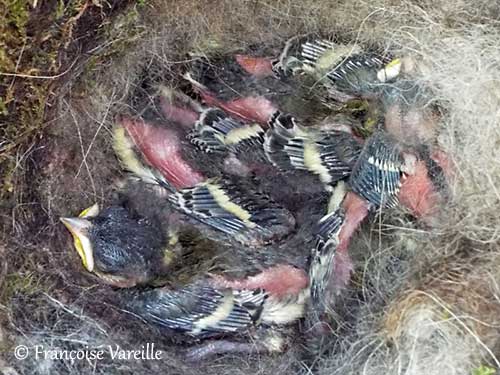
May 21
Old stove
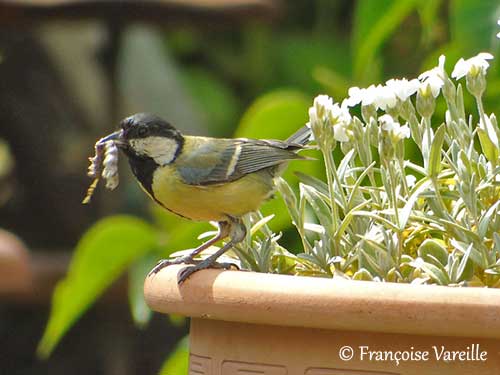
Today, May 22, it's a great day! In the old stove, a first chick left the cup of the nest and begins to move to the bottom of the stove.
During the day, others come to join him in a corner. We can see the youngest, not yet feathered like the others, but alive for the moment. Hope that adults will help him now that it is more accessible!
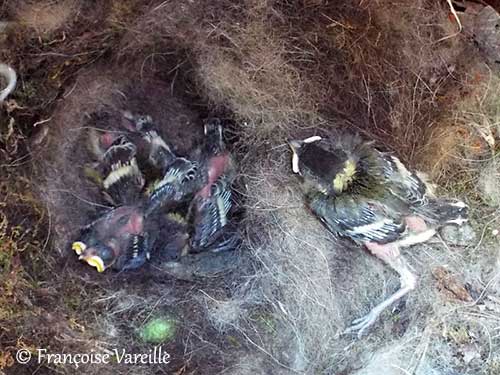
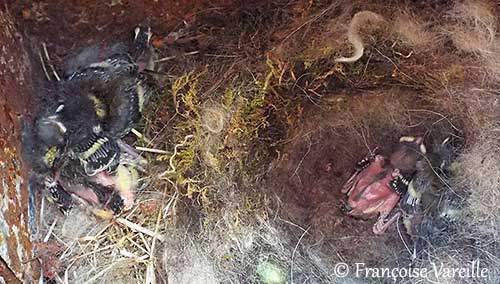
May 22
Old stove
May 22
Old stove
Two news today May 23, a good and a bad one.
Let's start with the bad to finish on a good impression with the good one !
In the nest of the stove, the chick that had moved away from the group the day before died. As he was drawing a lot of ants into the nest, Françoise removed it. The female returned to feed the remaining chicks without any particular reaction. This type of event often happens, unfortunately. But Nature is so. The strongest are left.
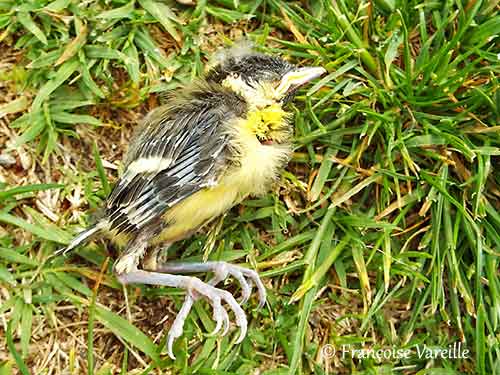
May 23
A chick is dead
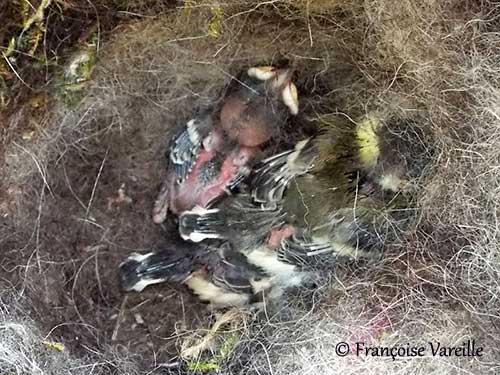
May 23
Old stove
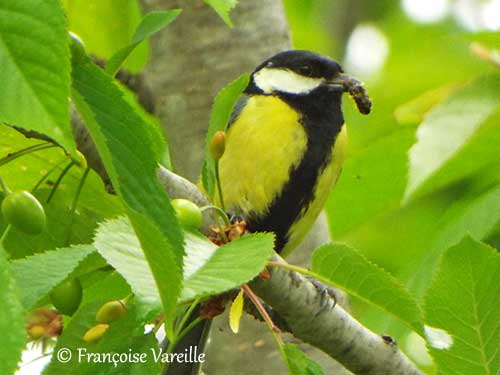
May 23
Male near the watering can
On May 24, everything is quiet in the watering can. The chicks are huddled against each other and are still regularly brooded by the female. They appear to be healthy.
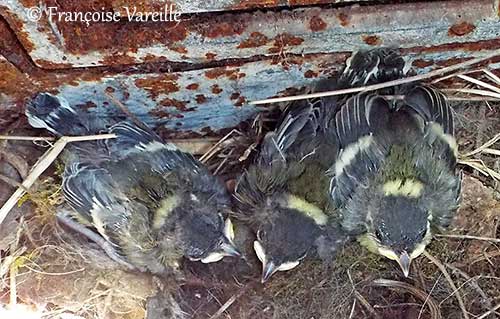
May 24
Old stove
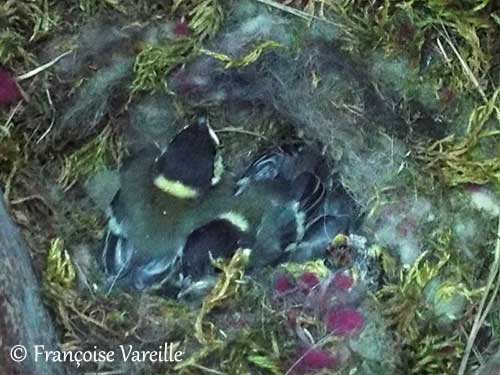
May 24
Watering can
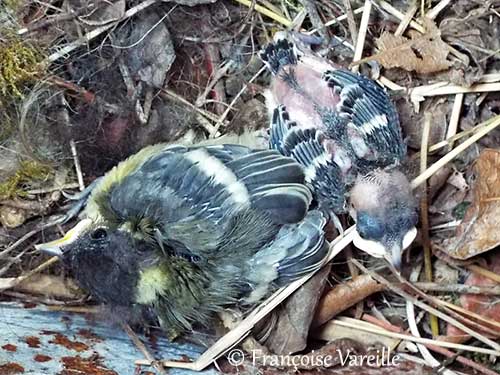
May 24
Old stove
Unfortunately, in the morning of May 25, when Françoise visits the nests, she notices that Nature has done her work ... The youngest of the stove is dead. Probably too weak to access food because "crushed" by his brothers and sisters, he did not receive enough prey to survive and fly away. Let's hope that the others will be able to leave very quickly and without much difficulty.
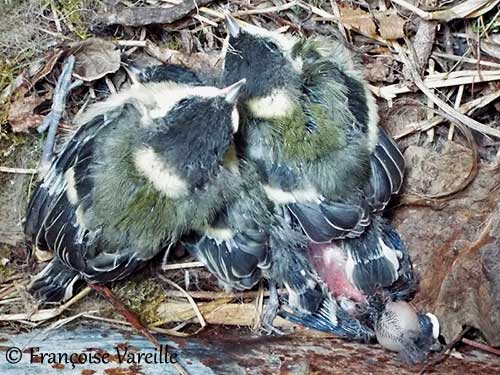
May 25
Old stove
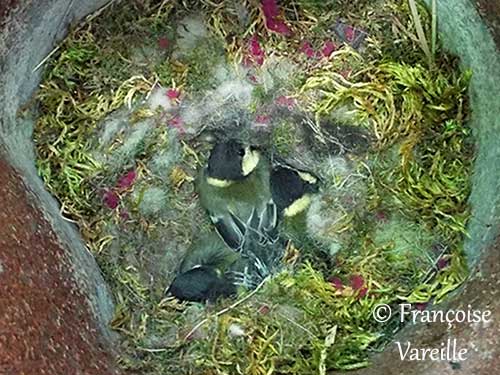
May 26
Watering can
But on May 27, a picture shows us that actually, four chicks are in the watering can. It rains a lot outside, and they will probably not come out until the weather has calmed down.
The adult who feeds them is soaked and exhausted, but he always hunts to prepare them for the big departure.
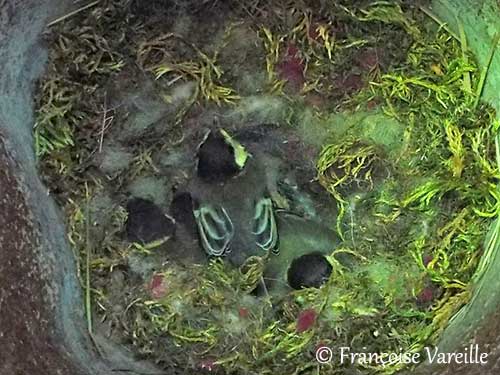
May 27
Watering can
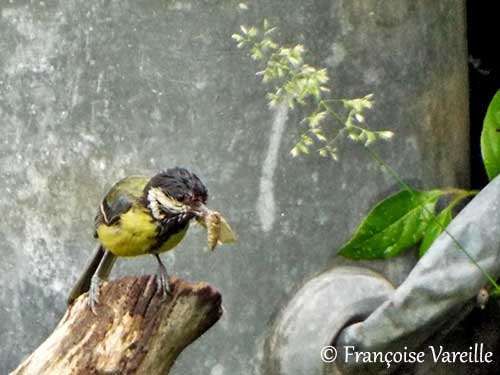
In the old stove, the chicks are well awake and their eyes are brighter than yesterday. Tirelessly, the parents feed them in both nests.
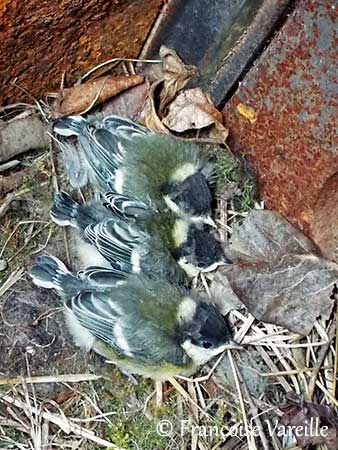
May 27
Old stove
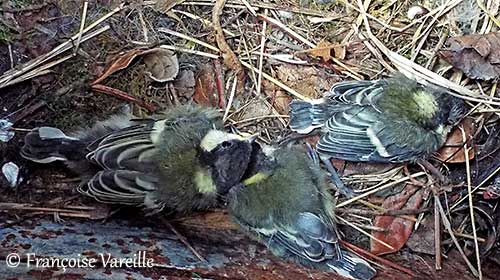
May 28
Old stove
On the other hand, in the watering can, the four small ones are superb. Hope they will hold until the end!
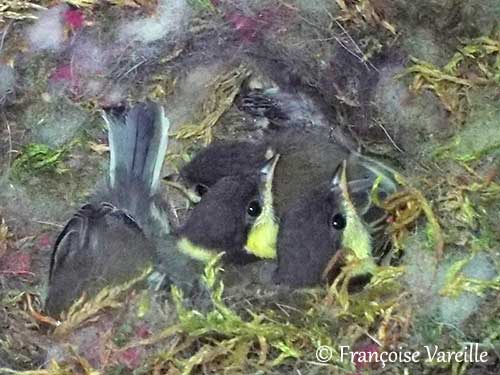
May 28
Watering can
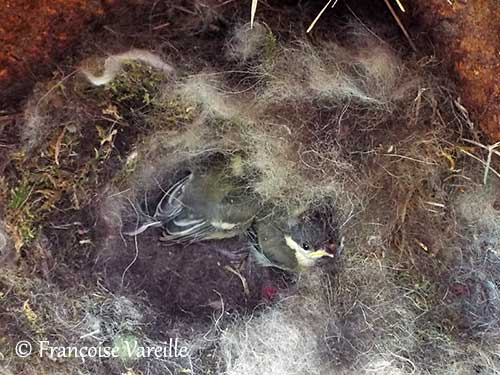
May 29
Old stove
And in the watering can, it seems that the air of the garden begins to smell good !!! A small tit looks fiercely to the exit, standing a little along the wall. Like a little desire to go elsewhere?
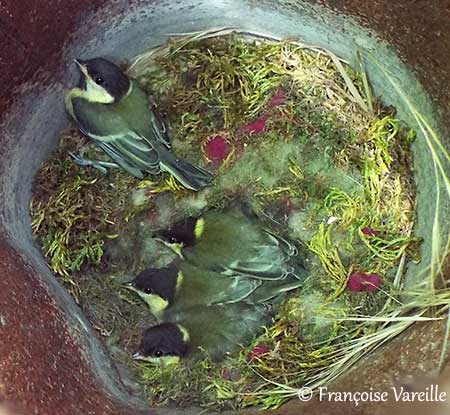
May 29
Watering can
And finally on May 29, first exit from the stove! It is cute and full of life. Both juveniles are in the garden. Good luck! Nature is so beautiful !
The first contact is on the ground, but in the grass for more softness.
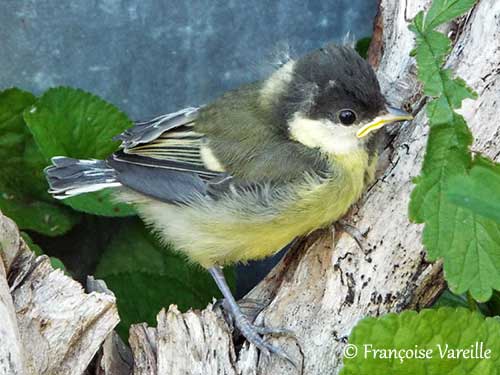
May 29
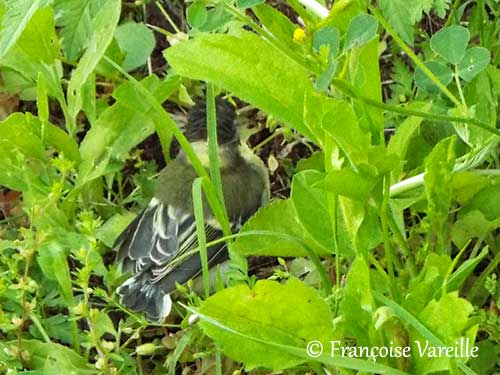
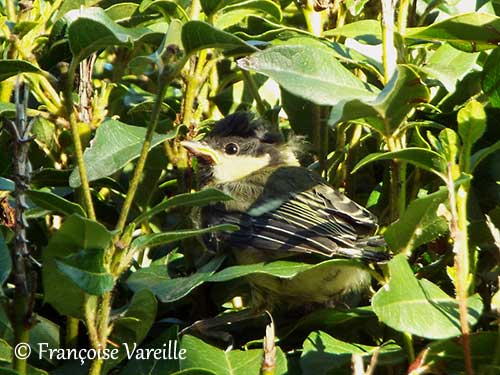
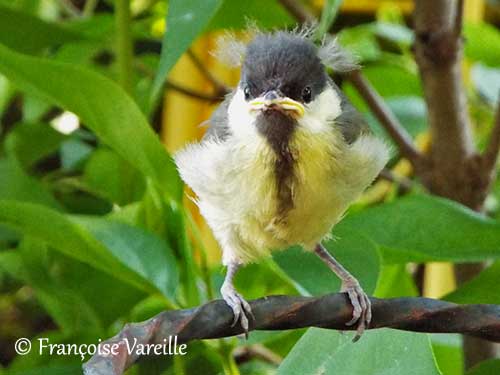
On the morning of the 30th, the nest of the watering can was found empty too. This entire little world flew into this heavenly garden under the protection of adults for some time.
Wish them good luck ! The first days are difficult, but spring is here with its lot of insects. They will not miss any food.

May 30
Watering can
Conclusion of this observation:
This observation has confirmed some things, such as the replacement of a brood in case of loss of the first. In the watering can, a second egg laying of 7 eggs was deposited and 4 juveniles flew on May 29, 19 days after the first births of May 10, and 17 days after the last of May 17.
The nest has been cleaned since there is no trace of the dead chicks. The materials were arranged throughout the nesting period. The chicks grew well and very regularly, confirming, if necessary, that smaller clutches were more likely to survive than the others.
In the stove, the first egg was found on April 12, there were 3 on the 14th, and on April 19, 8 eggs were visible. Finally, we could count 11 eggs on April 27th. Births take place on May 10th and 11th. The parents feed tirelessly the chicks with green caterpillars at first, and then the prey becomes more varied as the young are growing.
Unfortunately, there were dead chicks in this nest. Too large brood, parasites, disease, problem with rust very present on the walls of the stove ... The debate remains open at this stage.
A first dead chick was removed from the nest because it attracted the ants. The last dead chick was removed yesterday, after the flight of the two remaining chicks. The other corpses were cleaned by the adults, which did not have to be easy if we compare the size of the parents to those of the young people!
For information, in the stove, the cup is 4 to 6 centimetres deep for a diameter of 8 centimetres. The chicks were literally "piled up" on each other, and that may have prevented parents from feeding everyone properly. Those who were at the bottom probably did not get back in time to receive the food.
But the result is honorable, with 6 fledglings in the wild for 18 eggs in all for both nests. With all the dangers that threaten our birds today, a third of success is already a good result!
BUT !!!!
A good surprise awaited Françoise after the flight of young tits ... Four days later, on June 3, there was already an egg in the watering can. And on June 4th, three eggs are visible in a similar but clean and welcoming nest.
It would seem that the same couple is putting another brood on the way. This is probably a well-established couple and relatively young adults.
The male will take care of the juveniles for a few days, while the female starts this brood which will end around late June / early July.
The chicks of this brood, however, will have more trouble feeding afterwards, because of the dominance of previous juveniles. But in this beautiful garden, prey are not lacking. Let's hope that everything goes well for them!
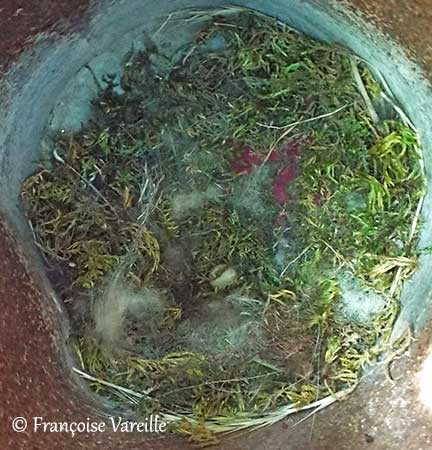
June 3
Watering can
1 egg
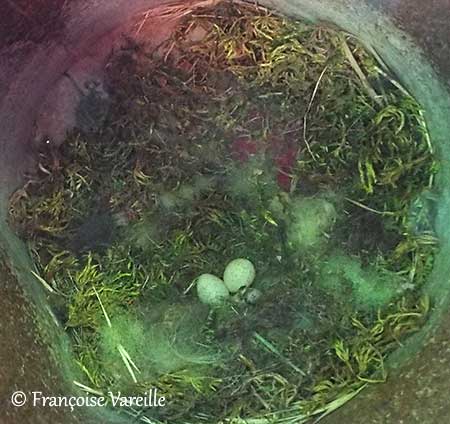
June 4
Watering can
3 eggs
On June 7, seven eggs have been laid and are regularly incubated by the female. We can see that the nest has duller colors than the previous one, but it seems warm and comfortable, so that this second brood comes to the end successfully.
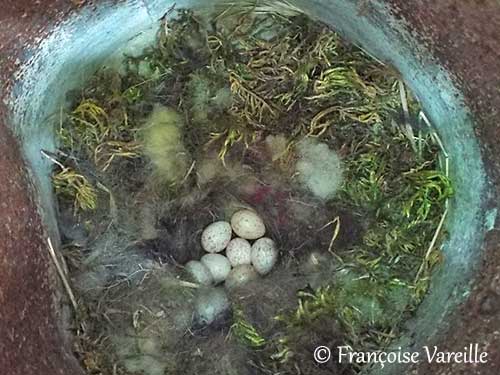
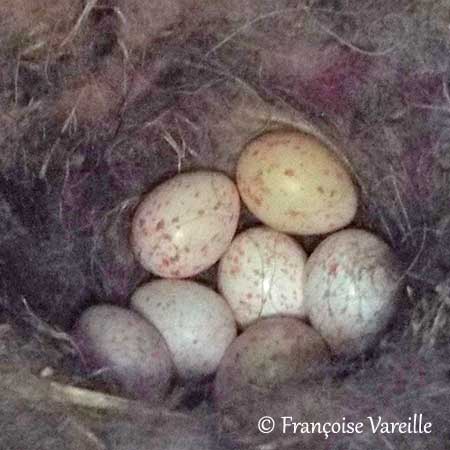
June 10
Watering can
7 eggs
June 10
Watering can
7 eggs
One thing, however, is surprising. If we look at the dates of laying, here is what emerges:
3/06: 1 egg
4/06: 3 eggs
5/06: 5 eggs
6/06: 6 eggs
7/06: 6 or 7 eggs
There would have been 2 eggs deposited on the 4th but also on June 5th, which is not quite the norm, knowing that it takes up to 24 hours for the egg to form. The female usually lays her egg early in the morning before flying away, and the next egg is formed only at the end of the following night to be laid at the first light of day.
It happened two days in a row...
Let's wait for more! The female incubates regularly and for the moment everything seems normal.
June 17, everything is calm. No birth at the moment. An egg darker than others intrigues us a little, but the future will tell us what it is!
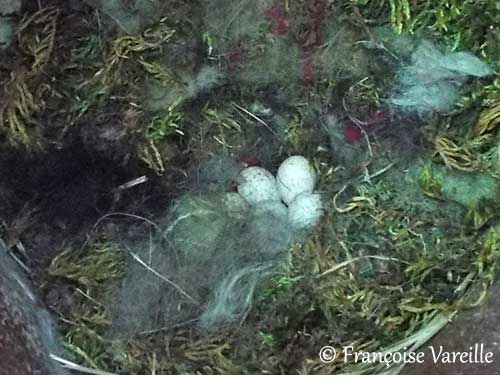
June 4
Watering can
5 eggs
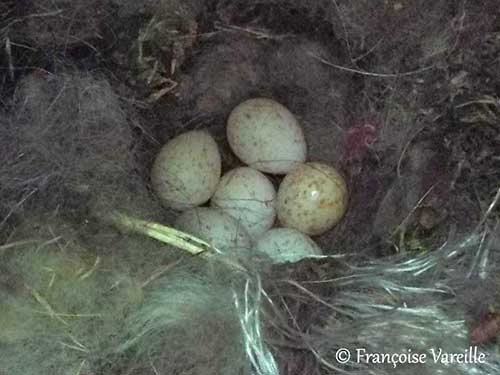
June 6
Watering can
6 eggs
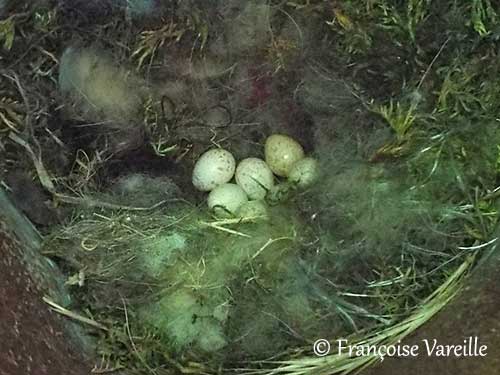
June 7
Watering can
6 or 7 eggs
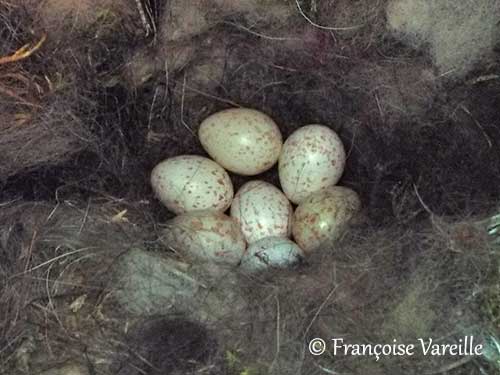
June 9
Watering can
7 eggs
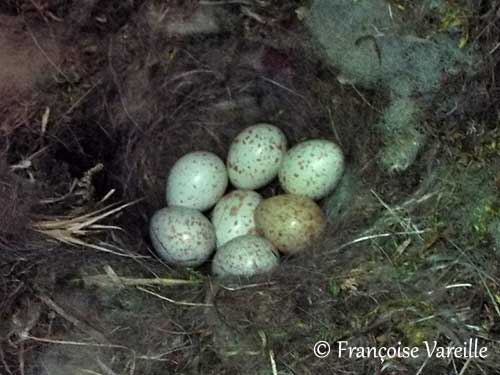
June 17
Watering can
Surprise on June 19th! Three chicks are born. The darker egg has not yet hatched. We have to wait.
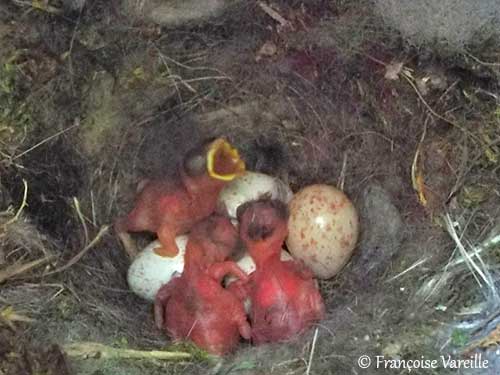
June 19
Watering can
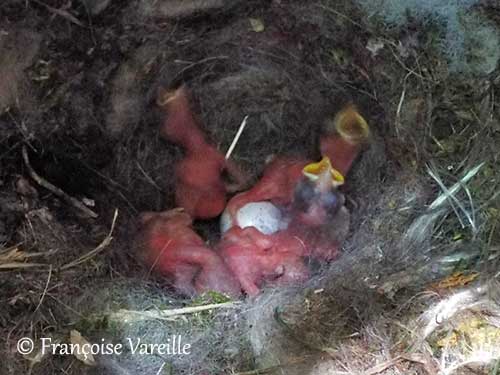
June 20
Watering can
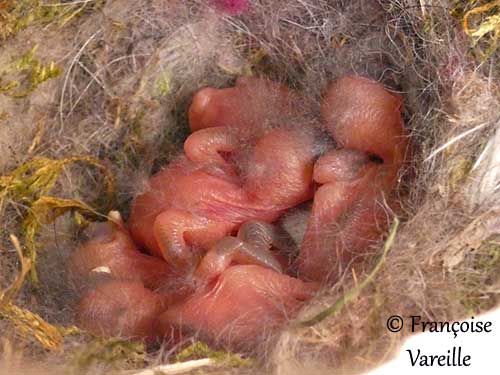
June 22
Watering can
An egg is visible
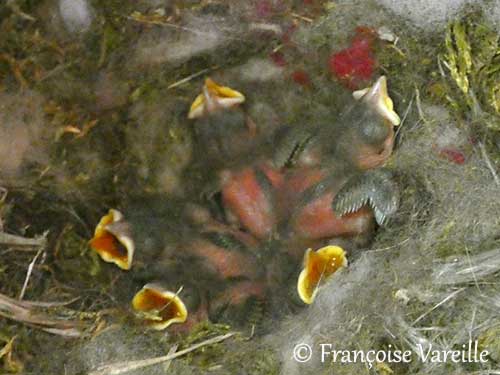
June 25
Watering can
On the morning of June 26, two chicks came out of the cup of the nest because of the heat. An intact egg had been seen in the middle of the little ones and the wool that lines the structure. But it is probably too late for a new hatching.
The feathers grow fast now. The chicks are beautiful !
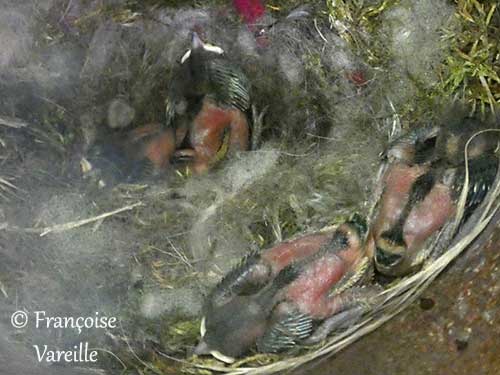
June 26
Watering can
Early in the morning of June 27, the chicks probably suffer from the heat wave that rages over the country and the air must be rare in the watering can. They come out from time to time from the bottom of the nest to have less heat and sleep with the beak open.
Today, no more eggs are visible and the five young ones are all at the same stage of growth. The feathers are growing well, but it will take another week before they fledge.
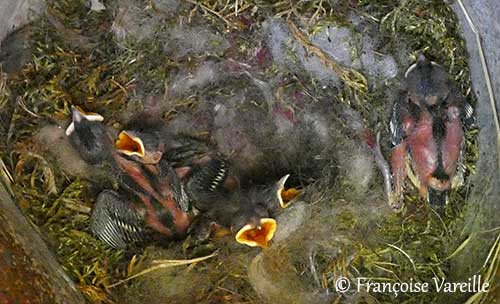
June 27
Watering can
On June 28, the five little ones are still alive despite the intense heat of the day before! Parents must feed them properly so that they do not dehydrate.
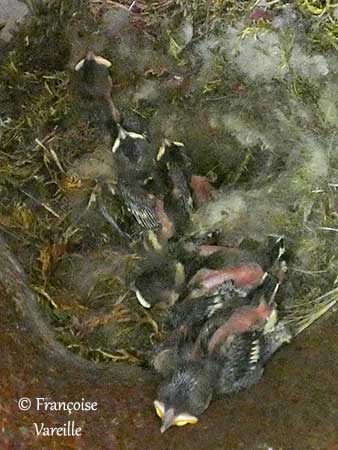
June 28
Watering can
On July 1st we can see (with difficulty) always five chicks. Despite the heat, they stay literally piled on top of each other. Their eyes are open and the feathers grow incredibly fast. They will soon fly away, probably towards the end of the week.
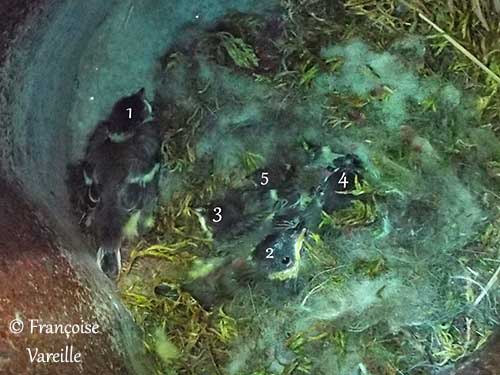
July 1st
Watering can
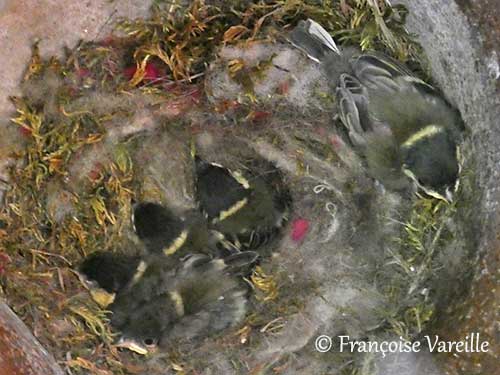
July 3
Watering can
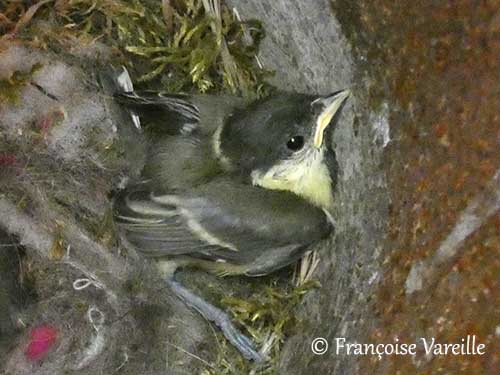
July 3
Watering can
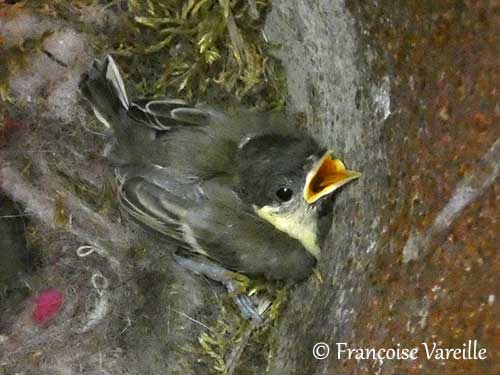
July 3
Watering can
On the 5th of July at midday, we still have five chicks crowded in the nest, except the one who seems to be isolating itself from the others, probably the firstborn.
The bad weather of the last two days, with wind, storm and hail probably did not help to cause the exit of the nest which seems imminent.
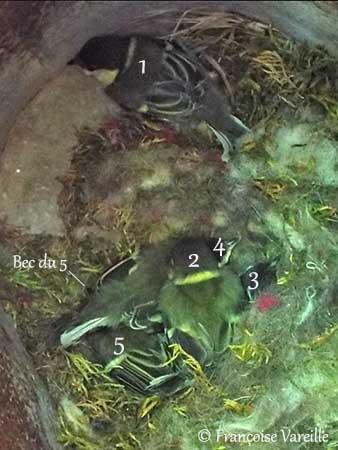
July 5
Watering can
Morning
Late afternoon that same day, July 5, another tit moves away from the cozy cocoon. Their plumage is perfect and complete. The flight will be easy.
Will they still be here tomorrow ?
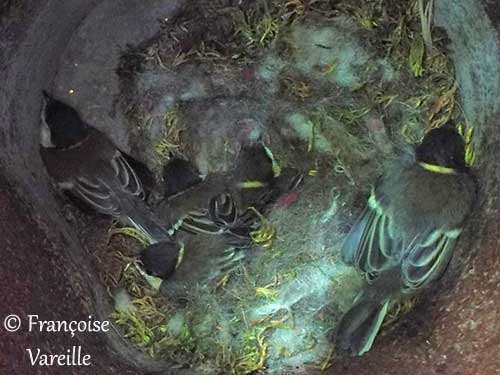
July 5
Watering can
Late afternoon
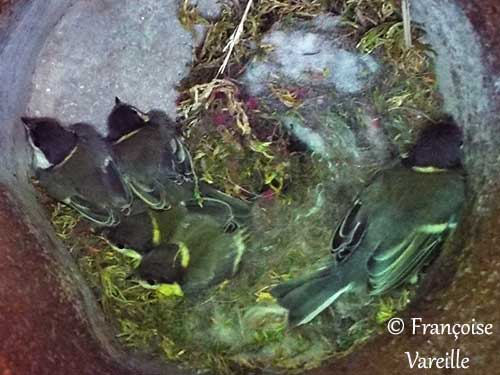
July 6
Watering can
End of the morning
Surprise! On the evening of July 7, our chicks are still there!
It will be a month tomorrow that the last egg has been laid. They take their time and are pampered by adults!
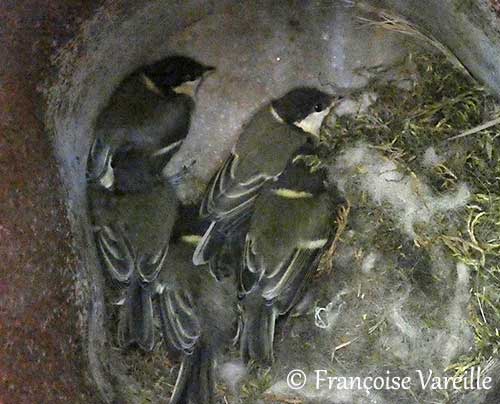
July 7
Watering can
Late afternoon
And here's the result... in the morning of July 8, Françoise can only note the departure of the five young tits. They stayed one month at the nest and left in good health and with complete plumage.
It is not uncommon for chicks of second broods to be fed longer by adults, even when fledged. The parents are not in a hurry to start the next clutch, as this species usually produces two broods per season. If we also consider the first brood disturbed and abandoned, this couple has fulfilled its mission!
Hope that everything will be fine for these juveniles and wish them good luck!
Another big thank you to Françoise for the quality of the information, the diversity of the images and the regular follow-up of this extraordinary observation.
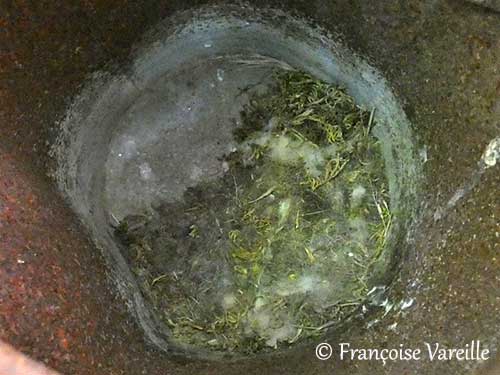
July 8
Watering can
Everybody is gone !
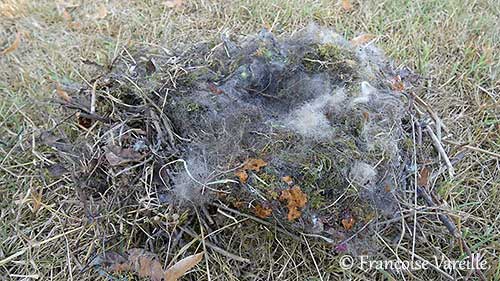
Old stove
Mid-August 2019
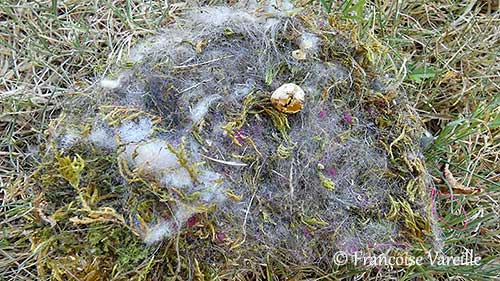
Watering can
Mid-August 2019